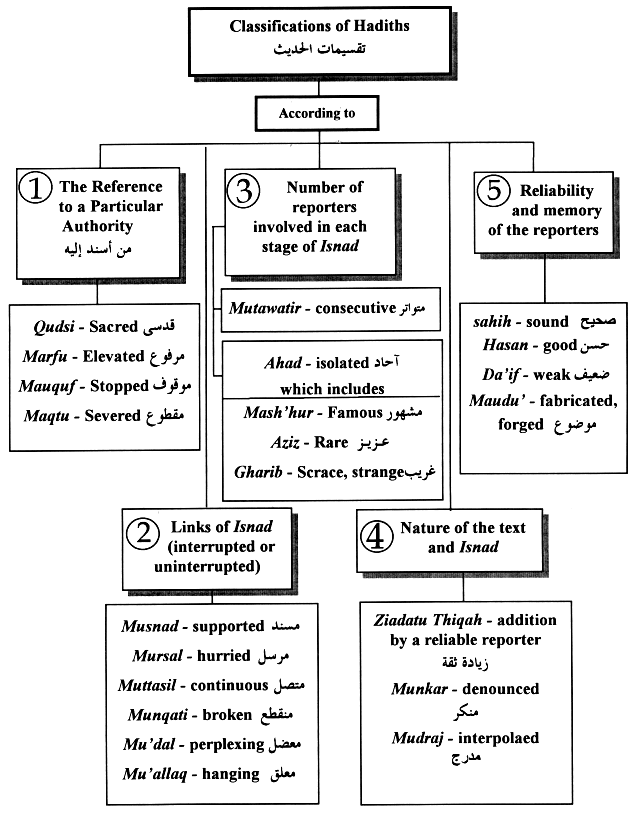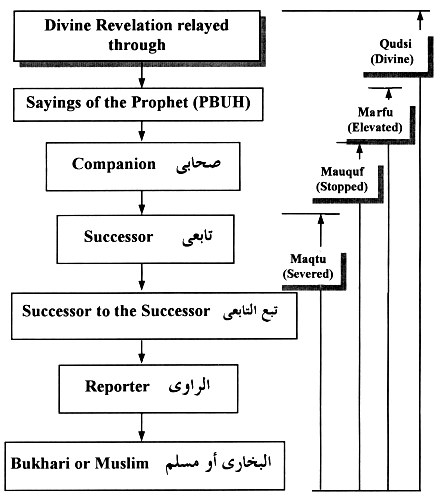|
The Science
of Hadith

We have, Without
doubt, sent down the message: and we will assuredly guard
it (from corruption). (Qur'an 15:9)
The promise
made by Allah (SWT) in Qur'an 15:9 is obviously fulfilled
in the undisputed purity of the Qur'anic text throughout
the fourteen centuries since its revelation. However, what
is often forgotten by many Muslims is that the divine promise
also includes, by necessity, the Sunnah
of the Prophet (saws), because the Sunnah
is the practical example of the implementation of the Qur'anic
guidance, the wisdom taught to the Prophet (saws) along
with the scripture, and neither the Qur'an nor the Sunnah
can be understood correctly without the other.
Allah (SWT)
preserved the Sunnah
by enabling the companions and those after them to memorize,
write down and pass on the statements of the Prophet (saws),
and the descriptions of his way, as well as to continue
the blessings of practicing the Sunnah.
Later, as the
purity of the knowledge of the Sunnah
became threatened, Allah (SWT) caused the Muslim Ummah
to produce individuals with exceptional memory skills and
analytical expertise, who travelled tirelessly to collect
thousands of narrations and distinguish the true words of
prophetic wisdom from those corrupted by weak memories,
from forgeries by unscrupulous liars, and from the statements
of the large number of Ulama
(scholars), the companions and those who followed their
way. All of this was achieved through precise attention
to the words narrated, and detailed familiarity with the
biographies of the thousands of reporters of hadith.
The methodology
of the expert scholars of hadith
in assessing the narrations and sorting out the genuine
from the mistaken and fabricated, for ms the subject matter
of the science of hadith.
In this article a brief discussion is given of the terminology
and classifications of hadith.
Components of Hadith
A hadith
is composed of three parts (see the figure [below]):

Matn
(text), isnad (chain
of reporters), and taraf
(the part, or the beginning sentence, of the text which
refers to the sayings, actions or characteristics of the
Prophet (saws), or his concurrence with others action).
The authenticity of the hadith
depends on the reliability of its reporters, and the linkage
among them.
Classifications of Hadith
A number of classifications
of hadith have been
made. Five of these classifications are shown in the figure
[below], and are briefly described subsequently.

- According
to the reference to a particular authority
Four types of hadith
can be identified.
-
Qudsi -
Divine; a revelation from Allah (SWT); relayed with
the words of the Prophet (saws).
-
Marfu -
elevated; a narration from the Prophet (saws), e.g.
I heard the Prophet (saws) saying ...
-
Mauquf-
stopped: a narration from a companion only, e.g.,
we were commanded to ...
-
Maqtu' -
severed: a narration from a successor.

- According
to the links of Isnad
- interrupted or uninterrupted
Six categories can be identified.
-
Musnad -
supported: a hadith
which is reported by a traditionalist, based on what
he learned from his teacher at a time of life suitable
for learning; similarly - in turn - for each teacher
until the isnad
reaches a well known companion, who in turn, reports
from the Prophet (saws).
-
Mutassil
- continuous: a hadith
with an uninterrupted isnad
which goes back only to a companion or successor.
-
Mursal -
hurried: if the link between the successor and the
Prophet (saws) is missing, e.g. when a successor says
"The Prophet said...".
-
Munqati
- broken: is a hadith
whose link anywhere before the successor (i.e., closer
to the traditionalist recording the hadith)
is missing.
-
Mu'adal
- perplexing: is a hadith
whose reporter omits two or more consecutive reporters
in the isnad.
-
Mu'allaq
- hanging: is a hadith
whose reporter omits the whole isnad
and quotes the Prophet (saws) directly (i.e., the
link is missing at the beginning).
- According
to the number of reporters involved in each stage of Isnad
Five categories of hadith
can be identified:
-
Mutawatir
- Consecutive: is a hadith
which is reported by such a large number of people
that they cannot be expected to agree upon a lie,
all of them together.
-
Ahad - isolated:
is a hadith which
is narrated by people whose number does not reach
that of the mutawatir.
It is further classified into:
-
Mash'hur
- famous: hadith
reported by more than two reporters.
-
Aziz - rare,
strong: at any stage in the isnad,
only two reporters are found to narrate the hadith.
-
Gharib -
strange: At some stage of the Isnad,
only one reporter is found relating it.
- According to the
nature of the text and isnad
-
Munkar -
denounced: is a hadith
which is reported by a weak narrator, and whose narration
goes against another authentic hadith.
-
Mudraj -
interpolated: an addition by a reporter to the text
of the hadith
being narrated.
- According
to the reliability and memory of the reporters
This provides the final verdict on a hadith
- four categories can be identified:
-
Sahih -
sound. Imam Al-shafi'i states the following requiremetts
for a hadith,
which is not mutawatir,
to be acceptable "each reporter should be trustworthy
in his religion; he should be known to be truthtul
in his narrating, to understand what he narrates,
to know how a different expression can alter the meaning,
and to report the wording of the hadith
verbatim, not only its meaning".
-
Hasan -
good: is the one where its source is known and its
reporters are unambiguous.
-
Da'if -
weak: a hadith
which fails to reach the status of hasan.
Usually, the weakness is: a) one of discontinuity
in the isnad,
in which case the hadith
could be - according to the nature of the discontinuity
- munqati (broken),
mu'allaq (hanging),
mu'dal (perplexing),
or mursal (hurried),
or b) one of the reporters having a disparaged character,
such as due to his telling lies, excessive mistakes,
opposition to the narration of more reliable sources,
involvement in innovation, or ambiguity surrounding
his person.
-
Maudu' -
fabricated or forged: is a hadith
whose text goes against the established norms of the
Prophet's sayings, or its reporters include a liar.
Fabricated hadith
are also recognized by external evidence related to
a discrepancy found in the dates or times of a particular
incident
|

